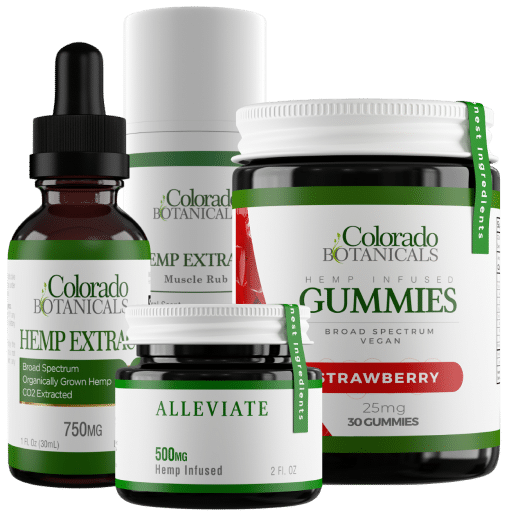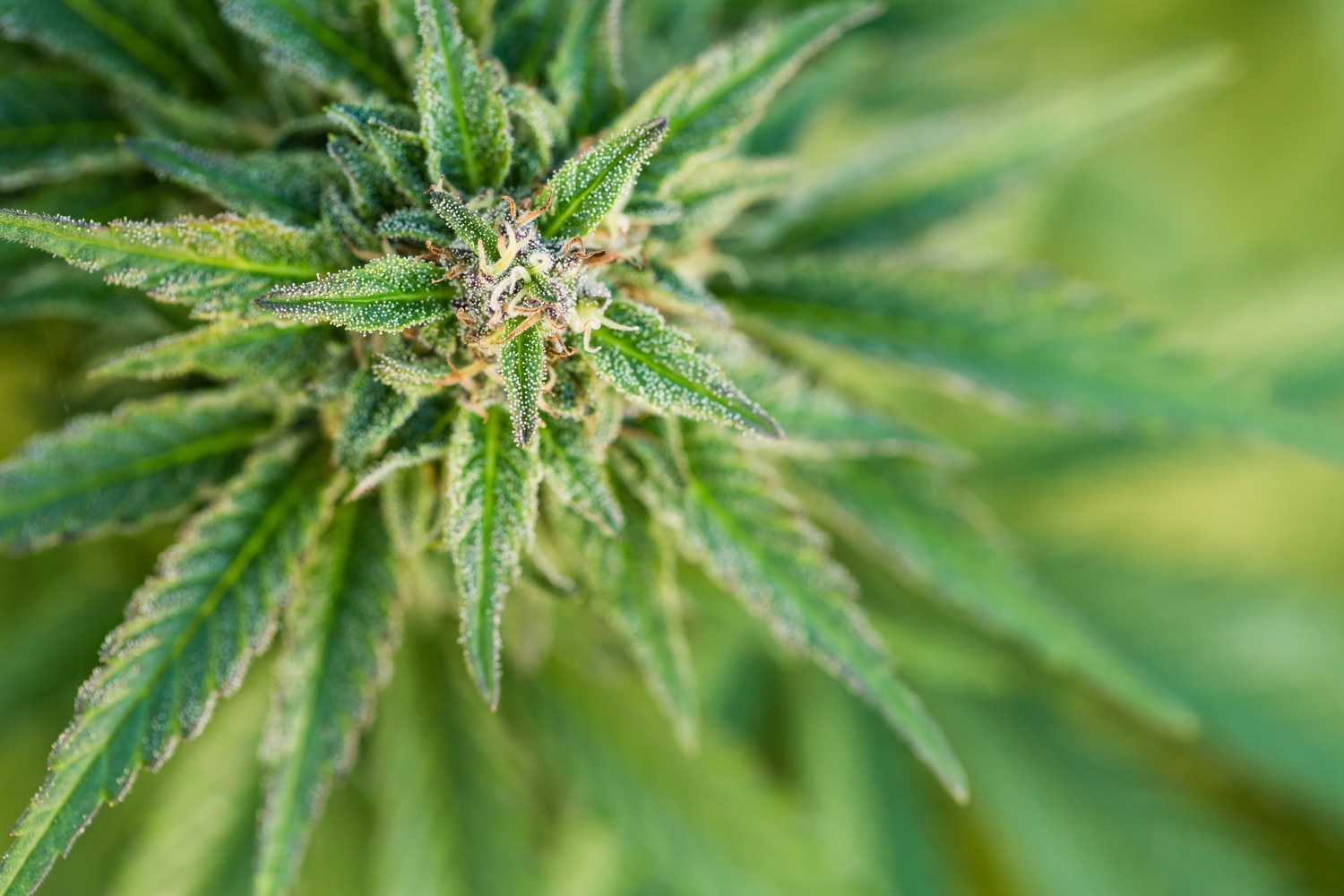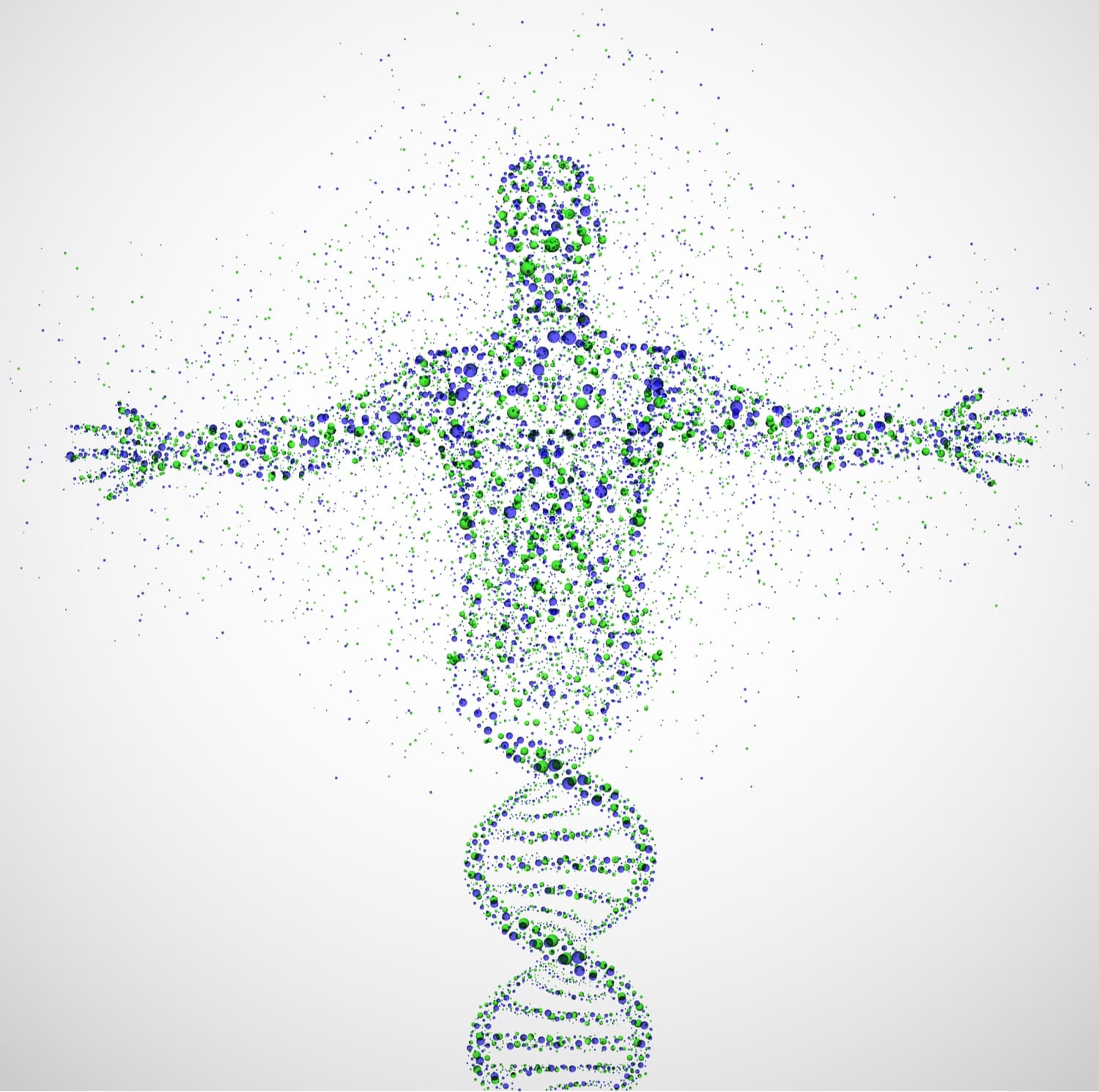Cannabidiol (CBD) is becoming widely used for many reasons, and for most people, it’s new them. Having to choose which dosage or the right product can be frustrating.
In this blog post, we hope to answer all your questions in an easy-to-read and informative fashion. We also have our Product Finder Quiz, making it easy for you to find the most suitable product based on your needs.
Consuming CBD is effective in whichever way you choose. However, there is a difference between the bioavailability of different consumption methods. Various forms of consuming CBD include sublingually (under the tongue), CBD infused edibles, smoking CBD-rich hemp, or other ways. Here is an outline of what we’ll cover:
-
- How is CBD absorbed in the body?
- What is CBD bioavailability?
- What are the different consumption methods of CBD?
- How effective is each consumption method?
How is CBD Absorbed in the Body?
How CBD works in the human body is being transferred from the site of admission (orally, topically, lungs, etc.) into the bloodstream, where it gets transported throughout the body. It then interacts with our Endocannabinoids and our CB1 & CB2 receptors. This system is called the Endocannabinoid System.
CB1 receptors were discovered in 1988 and are found throughout the entire body, but mostly in the Central Nervous System (CNS), which consists of the spinal cord and brain.
CB2 receptors were discovered in 1990 and mostly found outside the CNS in the Peripheral Nervous System (PNS), which mostly consists of the immune system and inflammatory conditions in microglia.
Endocannabinoids are receptors that are naturally produced internally, such as our serotonin receptors (Anandamide), 2-Arachidonoylglycerol (2-Ag), Vanilloid (TRPV1) receptors, orphan (GPR55) receptors, and nuclear (PPARS) receptors.
They are also entirely different from other neurotransmitters because:
-
- They’re produced on-demand when our body needs them (not readily available)
- The postsynaptic neuron produces them to act on the presynaptic neuron – they work in the opposite direction of all other transmitters. Put simply, they work on the previous neuron instead, which is unique.
What is the Bioavailability of CBD? What Is Bioavailability?
As with all vitamins, supplements, and drugs, much of the active ingredient passes through the body without being metabolized. Bioavailability defines how much of a compound, such as CBD the body absorbs or gets into your system.
According to The Balance, “Bioavailability” is defined as “the degree and rate at which an administered drug is absorbed by the body’s circulatory system.” Below we’ll be taking a look at each of the various consumption methods and bioavailability. Understanding the bioavailability of the different consumption methods also helps home in on the right CBD dose.
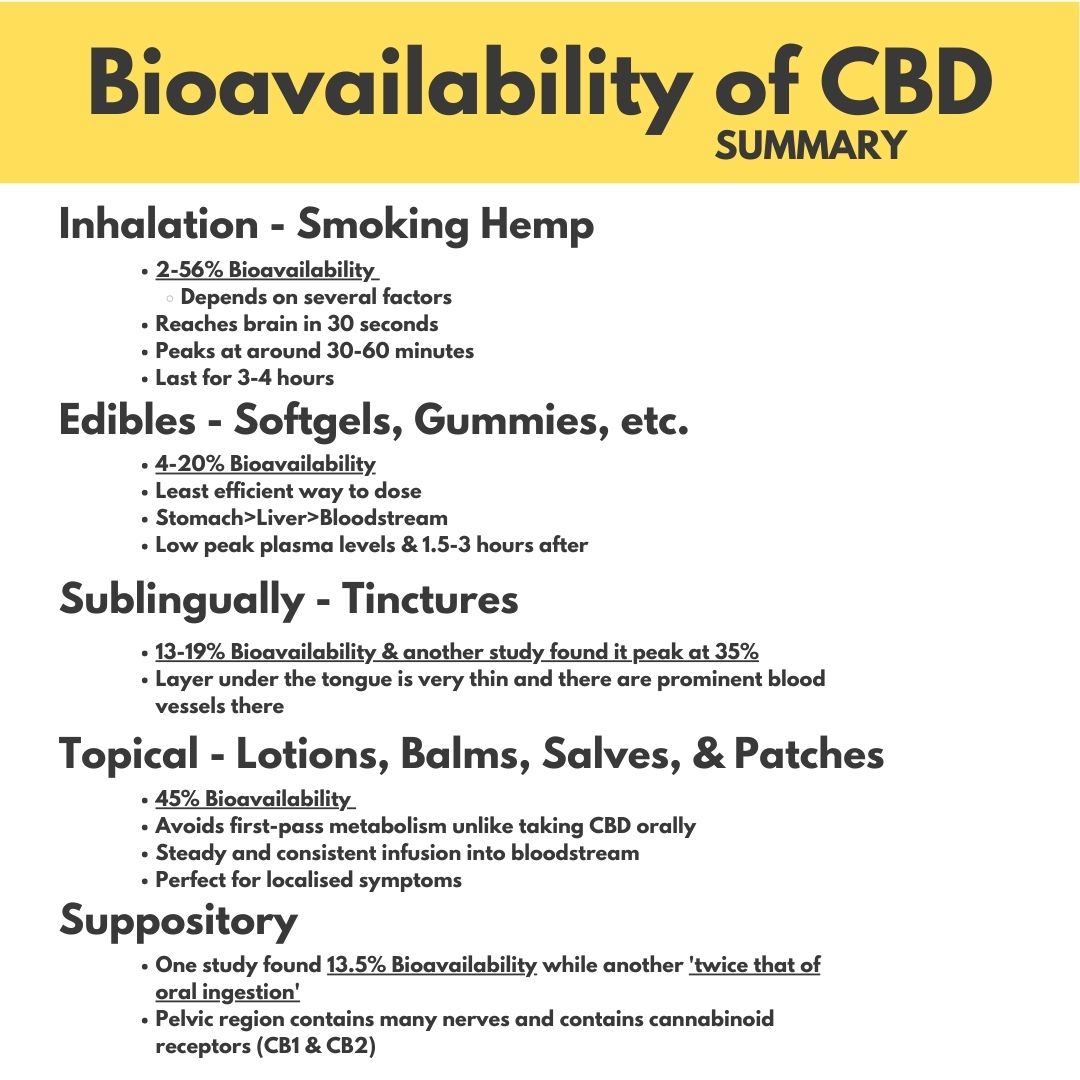
Smoking Hemp – Inhalation
A study shows that after smoking a hemp cigarette, which contained 19.2mg of CBD, it had a bioavailability of 31% and a half-life of 31 hours. They also found that the peak blood plasma levels occurred within 3 minutes. [1]
In another study of smoking cannabis, which is essentially the same, the bioavailability ranged from 2-56%, “due in part to intra- and inter-subject variability in smoking dynamics,” which can alter the dose delivery. The potency of the flower used, duration, hold time, and inhalation volume is all variables that significantly influence the dosage amount absorbed into the bloodstream. [2] [3] [4]
- ~50% of cannabinoids enter the lungs, almost all of that enters the body. [5]
- The study found bioavailability can range from 2-56%, depending on the variables.
- It reaches the brain in about 30 seconds, peaks at around 30-60 minutes, and lasts for 3-4 hours.
- Difficult to quantify dose-effect since several variables contribute to the absorbed dose.
- Potency
- Duration
- Hold time
- Inhalation volume
Edibles: Gummies and Softgels Orally Consumed
While gummy candies and chocolates are indeed fun to consume CBD, research shows this is the least efficient way to dose, which means it has low bioavailability.
When we eat cannabinoid-infused foods, much of the active ingredients fall prey to the process of digestion. Compounds that are digested by the stomach then go through the liver before they enter the bloodstream. Therefore, the absorption is low compared to other methods.
One study reported only about 4-20% of the total CBD dose gets absorbed and utilized by the body through edible consumption.
Compared to smoking/inhaling hemp that had peak plasma levels in 3 minutes, this study showed that chocolate cookie consumption resulted in low peak plasma levels and 1.5 to 3 hours after consuming.
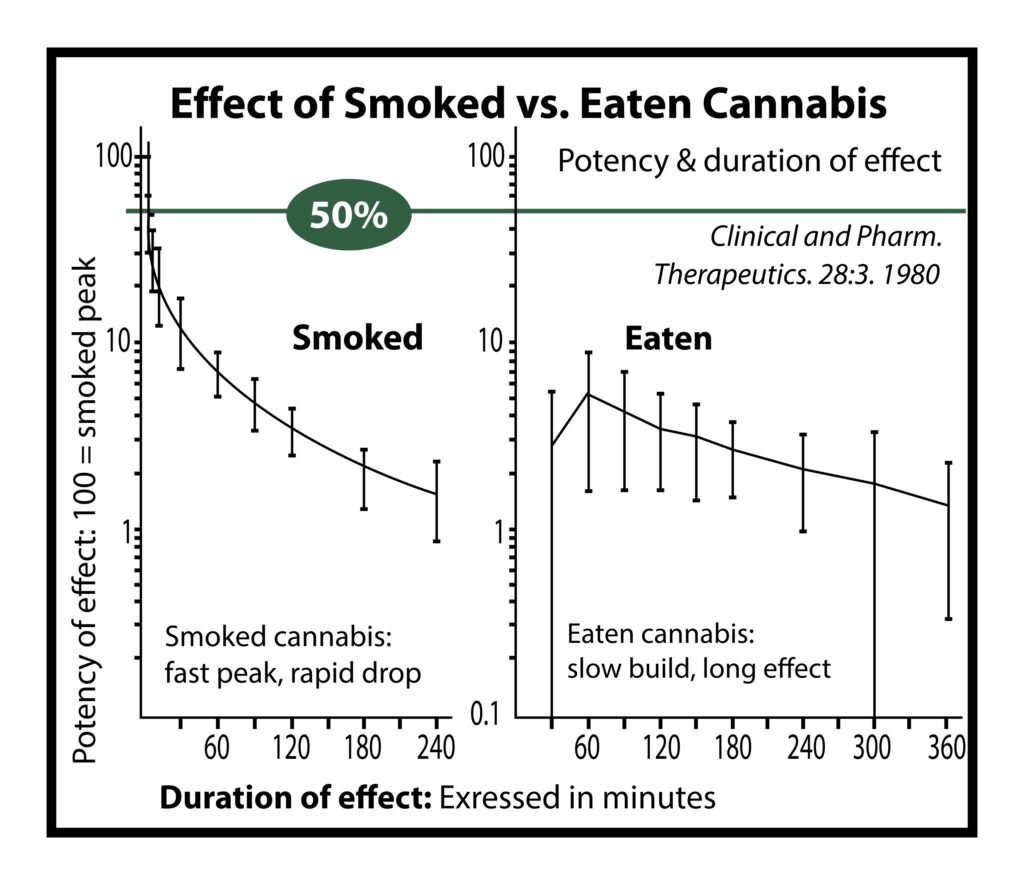
Sublingually: Tinctures Dissolved in MCT or Other Substitute Oil
Sublingual consumption is a way of giving medicine or supplement through the mouth by placing the oil under the tongue and holding it for 1-3 minutes. The layer under the tongue is very thin, and there are prominent blood vessels near the surface of the skin, which allows the cannabinoids, terpenes, and other essential plant compounds to absorb into the mucous membranes.
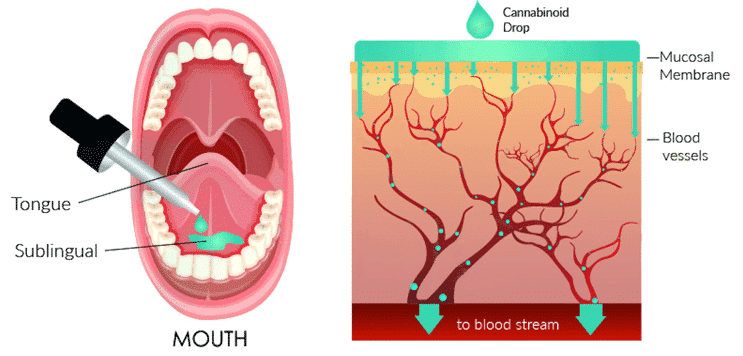
Bioavailability of Taking CBD Sublingually
According to a book called “CBD: A Patient’s Guide to Medicinal Cannabis,” Moskowitz states the bioavailability rate is 6-20% and onset effect of 15-60 minutes. In one study, oral bioavailability ranged from 13-19%, and in another study, they found that it could go as high as 35%. Remember that several factors contribute to the effectiveness, such as the quality of the CBD hemp extract and how long the person kept it under their tongue.
Ways of using tinctures:
- Oral application (squirting oil to the back of the tongue and swallowing)
- Sublingual (squirting oil under the tongue, holding for 1-3 minutes, and then swallowing)
- In food or liquids
To get the highest absorption possible, it’s best to place the oil under the tongue, hold for 2-3 minutes, and then swallow.
Topical Bioavailability: Lotions, Balms, Salves, & Patches
Administering CBD directly onto the skin is another widely used method. We recommend customers choose a topical product for localized symptoms, whether for arthritis in the fingers or inflammation on a specific part of their body. The topical and transdermal application of CBD has a bioavailability rate of 45%.
The primary benefit of this consumption method instead of other methods is that it avoids the first-pass metabolism effect that consuming CBD orally does and thus improves CBD’s bioavailability of cannabinoids in general.
It also allows for a steady and consistent infusion into the bloodstream that doesn’t fluctuate, increasing the time in our system. It’s similar to consuming CBD with edibles such as gummies. Still, instead of going through the stomach, then the liver, and finally, into your bloodstream, topical administration directly absorbs into the receptors on your skin.
Suppository Consumption of CBD Bioavailability: Rectal or Vaginal
The least popular method of CBD consumption is the suppository route. Although you may ask yourself, “why would someone choose this” it’s essential to know that some people don’t have a choice.
There are three methods of suppositories:
- Rectal Suppository: This is the most common among the three and is directly inserted into the rectum
- Vaginal Suppository: A method that women insert through their vagina
- Urethral Suppository: The least common method and is likely only to be inserted by a medical professional. This method is directly inserted into the urethra.
The suppository method has high bioavailability because the pelvic region contains many nerves that travel to the legs and up the spine. These nerves contain cannabinoid receptors (CB1 & CB2), with which CBD and other plant compounds interact to produce its effects.
From one study conducted on monkeys, the bioavailability was 13.5%. While in another study on two patients, they concluded that bioavailability was approximately twice that of oral ingestion but unfortunately did not provide a percentage. The study also found that the peak plasma levels occurred within 2-8 hours.
How to Increase Bioavailability of CBD
Consuming a high-fat snack will help the absorption of CBD into the body. CBD is a fat-soluble compound, meaning it dissolves in fats and fatty oils.
Some good choices of healthy fats:
- Peanut Butter
- Almond Butter
- Avocado
- Nuts
It’s smart to do what you can to get the most out of your CBD product. One way to do so is by consuming a high fatty snack when you take CBD.
How to take CBD and Highest CBD Bioavailability
Choosing the right product all depends on what the user is trying to achieve. Do you prefer to go with the product with the highest bioavailability, or do you prefer to go with that specific product because you like that consumption method?
Although we don’t recommend any smoking or vaping during this age, if you’re looking for the CBD product with the highest bioavailability, it would be smoking hemp. If you’re looking for the easiest consumption method of CBD, it would be softgels or edibles.



